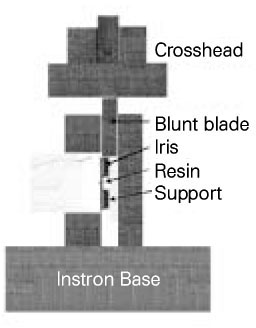J Korean Acad Conserv Dent.
2004 Mar;29(2):170-176. 10.5395/JKACD.2004.29.2.170.
The effect of cavity wall property on the shear bond strength test using iris method
- Affiliations
-
- 1Department of Conservative Dentistry & Dental Research Institute, College of Dentistry, Seoul National University, Korea. beigeh@hanmail.net
- 2Department of Conservative Dentistry, The Institute of Oral Health Science, Samsung Medical Center, Sungkyunkwan University, School of Medicine, Korea.
- KMID: 1987091
- DOI: http://doi.org/10.5395/JKACD.2004.29.2.170
Abstract
OBJECTIVES
In the unique metal iris method, the developing interfacial gap at the cavity floor resulting from the cavity wall property during polymerizing composite resin might affect the nominal shear bond strength values. The aim of this study is to evaluate that the iris method reduces the cohesive failure in the substrates and the cavity wall property effects on the shear bond strength tests using iris method.
MATERIALS AND METHODS
The occlusal dentin of 64 extracted human molars were randomly divided into 4 groups to simulate two different levels of cavity wall property (metal and dentin iris) and two different materials (ONE-STEP(R) and ALL-BOND(R) 2) for each wall property. After positioning the iris on the dentin surface, composite resin was packed and light-cured. After 24 hours the shear bond strength was measured at a crosshead speed of 0.5 mm/min. Fracture analysis was performed using a microscope and SEM. The data was analyzed statistically by a two-way ANOVA and t-test.
RESULTS
The shear bond strength with metal iris was significant higher than those with dentin iris (p = 0.034). Using ONE-STEP(R), the shear bond strength with metal iris was significant higher than those with dentin iris (p = 0.005), but not in ALL-BOND(R) 2 (p = 0.774). The incidence of cohesive failure was very lower than other shear bond strength tests that did not use iris method.
CONCLUSIONS
The iris method may significantly reduce the cohesive failures in the substrates. According to the bonding agent systems, the shear bond strength was affected by the cavity wall property.
Keyword
Figure
Reference
-
1. Buonocore MG. A simple method of increasing the adhesion of acrylic filling materials to enamel surfaces. J Dent Res. 1955. 34:849–853.
Article2. Finger WJ. Dentin bonding agents. Relevance of in vitro investigations. Am J Dent. 1988. 1:184–188.3. Retief DH. Standardizing laboratory adhesion tests. Am J Dent. 1991. 4:231–236.4. Holtan JR, Nystrom GP, Olin PS, Phelps RA, Phillips JJ, Douglas WH. Bond strength of six dentinal adhesives. J Dent. 1994. 22:92–96.
Article5. Van Noort R, Noroozi S, Howard IC, Cardew G. A critique of bond strength measurement. J Dent. 1989. 17:61–67.6. Davidson CL, Abdalla AI, de Gee AJ. An investigation into the quality of dentine bonding systems for accomplishing a durable bond. J Oral Rehabil. 1993. 20:291–300.
Article7. Van Noort R, Cardew G, Howard IC. A study of the interfacial shear and tensile stresses in a restored molar tooth. J Dent. 1988. 16:286–293.
Article8. DeHoff PH, Anusavice KJ, Wang Z. Three-dimensional finite element analysis of the shear bond test. Dent Mater. 1995. 11:126–131.
Article9. Versluis A, Tantbirojn D, Douglas WH. Why do shear tests pull out dentin? J Dent Res. 1997. 76(6):1298–1307.10. Watanabe LG, Lacy AM. Shear bond strength. Single plane vs. lap shear. J Dent Res. 1988. 67:Abstract No. 2159.11. Dickens SH, Milos MF. Relationship of dentin shear bond strengths to different laboratory test designs. Am J Dent. 2002. 15:185–192.12. Cho BH, Dickens SH, Bae JH, Chang CG, Son HH, Um CM. Effect of interfacial bond quality on the direction of polymerization shrinkage flow in resin composite restorations. Oper Dent. 2002. 27:297–304.13. Van Noort R, Cardew GE, Howard IC, Noroozi S. The effect of local interfacial geometry on the measurements of the tensile bond strength to dentin. J Dent Res. 1991. 70:889–893.
Article14. Choi KK, Condon JR, Ferracane JL. The effect of adhesive thickness on polymerization contraction stress of composite. J Dent Res. 2000. 79(3):812–817.
Article15. Armstrong SR, Boyer DB, Keller JC, Park JB. Effect of hybrid layer on fracture toughness of adhesively bonded dentin-resin composite joint. Dent Mater. 1998. 14:91–98.
Article16. Yoshikawa T, Sano H, Burrow MF, Tagami J, Pashley DH. Effects of dentin depth and cavity configuration on bond strength. J Dent Res. 1999. 78(4):898–905.
Article
- Full Text Links
- Actions
-
Cited
- CITED
-
- Close
- Share
- Similar articles
-
- Effect of cavity shape, bond quality and volume on dentin bond strength
- A comparative study of bond strength of recycled brackets
- A study of shear bond strength of bonded retainer according to the bonding method and type of wires
- The effect of adhesive thickness on microtensile bond strength to the cavity wall
- Effects of Saliva Contamination on Shear Bond Strength with Conventional, Moisture Insensitive, and Self-Etching Primers




